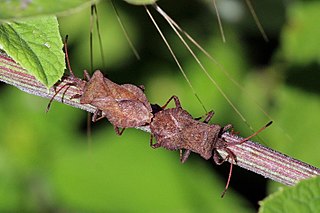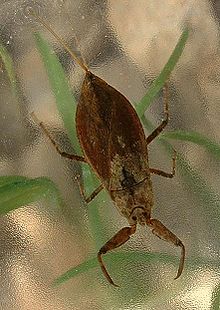
Hemiptera is an order of insects, commonly called true bugs, comprising over 80,000 species within groups such as the cicadas, aphids, planthoppers, leafhoppers, assassin bugs, bed bugs, and shield bugs. They range in size from 1 mm (0.04 in) to around 15 cm (6 in), and share a common arrangement of piercing-sucking mouthparts. The name "true bugs" is often limited to the suborder Heteroptera.

The latticed heath is a moth of the family Geometridae, belonging to the subfamily Ennominae, placed in the tribe Macariini. The genus was erected by Carl Linnaeus in his 1758 10th edition of Systema Naturae.

Nepidae is a family of exclusively aquatic Heteropteran insects in the order Hemiptera. They are commonly called water scorpions for their superficial resemblance to scorpions, due to their raptorial forelegs and the presence of a long slender process at the posterior end of the abdomen, resembling a tail. There are 14 genera in the family, in two subfamilies, Nepinae and Ranatrinae. Members of the genus Ranatra, the most widespread and species-rich genus, are sometimes called needle bugs or water stick insects as they are slenderer than Nepa.

Nepa cinerea is a species of water scorpion (Nepidae), found in most of Europe, including the British Isles, as well as North Africa and southern and northern Asia.

Ranatra is a genus of slender predatory insects of the family Nepidae, known as water scorpions or water stick-insects. There are around 100 Ranatra species found in freshwater habitats around the world, both in warm and temperate regions, with the highest diversity in South America and Asia. Fewer are found elsewhere, but include several African, some in North America, three from Australia and three from the Palearctic, notably the relatively well-known European R. linearis. Since Ranatra belongs to the family Nepidae which in turn belongs to the order Hemiptera, ranatrids are considered "true bugs".
The Nymphomyiidae are a family of tiny (2 mm) slender, delicate flies (Diptera). Larvae are found among aquatic mosses in small, rapid streams in northern regions of the world, including northeastern North America, Japan, the Himalayas, and eastern Russia. Around a dozen extant species are known, with two fossil species found in amber, extending back to the Mid Cretaceous. Under an alternative classification, they are considered the only living representatives of a separate, suborder called Archidiptera which includes several Triassic fossil members. The family has characteristics associated with the Nematocera as well as the Brachycera. The antennae are shortened as in the Brachycera and these flies are long, having a snout with vestigeal mouthparts, non-differentiated abdominal segments with large cerci. The wings are narrow and hair-fringed and have very weak venation. They are known to form cloud-like swarms in summer and the short-lived non-feeding adults have wings that fracture at the base shortly after mating.

Acanthosomatidae is a family of Hemiptera, commonly named "shield bugs" or "stink bugs". Kumar in his 1974 world revision recognized 47 genera; now this number is 55 genera, with about 200 species, and it is one of the least diverse families within Pentatomoidea. The Acanthosomatidae species are found throughout the world, being most abundant in high-latitude temperate regions and in subtropical regions at high altitudes.
Movile Cave is a cave near Mangalia, Constanța County, Romania discovered in 1986 by Cristian Lascu a few kilometers from the Black Sea coast. It is notable for its unique groundwater ecosystem abundant in hydrogen sulfide and carbon dioxide, but low in oxygen. Life in the cave has been separated from the outside for the past 5.5 million years and it is based completely on chemosynthesis rather than photosynthesis.

Water treaders, the superfamily Mesovelioidea, are insects in the order Hemiptera, the true bugs. They are semiaquatic insects that live in moist and wet habitat and on wet plant matter in several types of aquatic habitat.

Copium is a genus of lace bugs in the family Tingidae.

Coreus marginatus is a herbivorous species of true bug in the family Coreidae. It is commonly known as the dock bug as it feeds on the leaves and seeds of docks and sorrels. It is a medium-sized speckled brown insect, between 13 and 15 mm long as an adult, with a broad abdomen. It occurs throughout Europe, Asia and northern Africa. It is often found in dense vegetation, such as hedgerows and wasteland.

Centuria Insectorum is a 1763 taxonomic work by Carl Linnaeus, and defended as a thesis by Boas Johansson; which of the two men should for taxonomic purposes be credited with its authorship has been the subject of some controversy. It includes descriptions of 102 new insect and crustacean species that had been sent to Linnaeus from British America, Suriname, Java and other locations. Most of the new names included in Centuria Insectorum are still in use, although a few have been sunk into synonymy, and one was the result of a hoax: a common brimstone butterfly with spots painted on was described as the new "species" Papilio ecclipsis.

Chrysomela is a genus of leaf beetles found almost throughout the world, but not in Australia. It contains around 40 species, including 7 in eastern and northern Europe. It also includes at least 17 species in North America, including the cottonwood leaf beetle Chrysomela scripta.

Scorpaena scrofa, the red scorpionfish, bigscale scorpionfish, large-scaled scorpion fish, or rascasse is a venomous marine species of ray-finned fish in the family Scorpaenidae, the scorpionfishes. It is found in the Mediterranean Sea, in the eastern Atlantic Ocean and the western Indian Ocean.

Laccotrephes is a genus of water scorpion belonging to the family Nepidae. They are carnivorous insects that hunt near the water surface. They are not aggressive, but may inflict a painful bite if not handled carefully, which may cause a local reaction. There are about 60 species found in shallow stagnant or slow-moving waters in warm parts of Africa, Asia and Australia.

Phryganea is a genus of giant caddisflies in the family Phryganeidae. There are about 13 described species in the genus.
Salda is a genus of shore bugs in the family Saldidae. There are about 18 described species in Salda.
Curicta is a genus of waterscorpions in the family Nepidae native to freshwater habitats in the Americas. There are more than 15 species, with most restricted to South America. There are only two species in the United States: C. pronotata and C. scorpio.

Scorpio is a genus of scorpions belonging to the family Scorpionidae. The species in this genus are found in northern Africa and western Asia.















